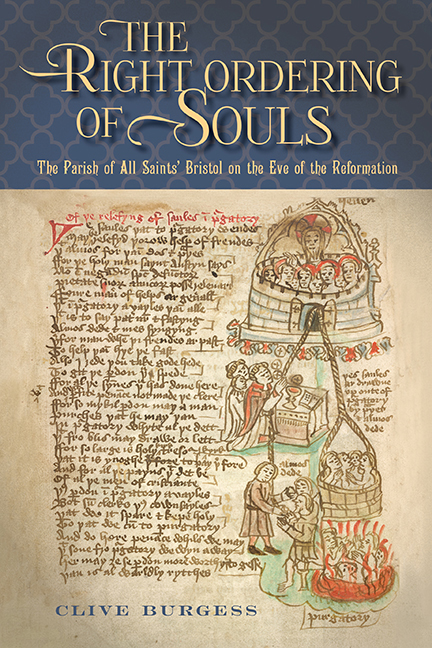Book contents
- Frontmatter
- Dedication
- Contents
- List of illustrations
- Acknowledgements
- Miscellaneous Frontmatter
- Abbreviations
- Notes
- map
- Part I For the increase of the divine service
- Part II All Saints’, Bristol, and its parishioners
- Part III Commemorating the dead
- Part IV Leaders and administrators
- Part V Ordering the parish
- 10 ‘Was but single and no thing of beauty’: Enhancing the parish church
- 11 ‘To the laud and the loving of Almighty God’: Increasing divine service in All Saints’
- Conclusion ‘What else, I ask you, is a city than a great monastery?’
- Appendices
- Bibliography
- Glossary
- Index
- Miscellaneous Endmatter
11 - ‘To the laud and the loving of Almighty God’: Increasing divine service in All Saints’
from Part V - Ordering the parish
Published online by Cambridge University Press: 05 May 2018
- Frontmatter
- Dedication
- Contents
- List of illustrations
- Acknowledgements
- Miscellaneous Frontmatter
- Abbreviations
- Notes
- map
- Part I For the increase of the divine service
- Part II All Saints’, Bristol, and its parishioners
- Part III Commemorating the dead
- Part IV Leaders and administrators
- Part V Ordering the parish
- 10 ‘Was but single and no thing of beauty’: Enhancing the parish church
- 11 ‘To the laud and the loving of Almighty God’: Increasing divine service in All Saints’
- Conclusion ‘What else, I ask you, is a city than a great monastery?’
- Appendices
- Bibliography
- Glossary
- Index
- Miscellaneous Endmatter
Summary
ALL Saints’ steady accumulation of vestments and vessels, no less than its swelling collection of liturgical books, flags up the significance attached to decorous ceremonial. As well as reinforcing general impressions of ample staffing in the church, it signals something, too, of the likely calibre of its clergy who, naturally, led the worship in All Saints’. For herein lay the parish's rationale: overshadowing any role that it played in pastoral instruction, All Saints’ – like every other ecclesiastical community – existed primarily to ‘increase divine service’. While the All Saints’ archive permits an unusually good impression of the liturgical developments sponsored by a wealthy urban neighbourhood, we nevertheless still ‘see through a glass, darkly’. Many of the finer points of day-to-day practice in All Saints’ remain obscure for the simple reason that surviving evidence was produced by and for the laity: it treats only obliquely with the clergy.
Unto the more laud and worship of Almighty God: Parishioners and the liturgy
As a result of their continual, and carefully commemorated, investment in the material provision underpinning the parish liturgy, parishioners displayed a clear determination to weave themselves into the rites observed within All Saints’. By commissioning chantries, for instance, wealthier parishioners provided for the celebration of daily Masses at designated altars within the church either for a fixed duration or, occasionally, in perpetuity; anniversary founders, too, ensured that exequies on the eve and a Requiem Mass on the morrow would be celebrated, either for a number of years or in perpetuity, ordinarily marking the date of their death. Parishioners exercised clear influence, both in enhancing the volume of divine service enacted within All Saints’ and also defining aspects, at least, of both the appearance and rhythm of sacral and commemorative rites. Vestments associated patron and chaplain, either at the daily Mass or when the priest swelled the number of those assisting with the daily office in the choir. Complementing the lessons of the bede roll and the General Mind (both of which impressed on parishioners who their benefactors were and what they had given), patrons took pains to identify their chaplains and, hence, their contribution in expanding the forces responsible for decorous worship within the parish.
- Type
- Chapter
- Information
- 'The Right Ordering of Souls'The Parish of All Saints’ Bristol on the Eve of the Reformation, pp. 383 - 412Publisher: Boydell & BrewerPrint publication year: 2018

